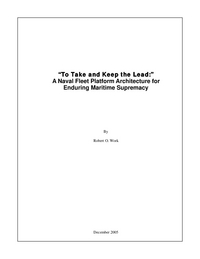
The Enduring Race
The global naval competition is an enduring “race” between an ever-changing, disparate group of competitors. A few select competitors enter the race to “win”—to become the number one contemporary naval power. Other competitors enter the race for nationally important but more modest goals, such as becoming a respected regional navy. Still others enter the race only to be part of the sea-going “community of commercial interests and righteous ideals,” with no intention of competing against stronger, more capable naval opponents. Ever since it was officially created in 1798, the Department of the Navy (DoN) has been responsible for monitoring the global naval competition, and developing and executing the US naval “racing strategy.” This strategy has changed over time as DoN strategists and planners have iteratively worked to answer three basic questions. First, given the national security roles assigned to the US armed forces in general and the DoN in particular, what is the most appropriate naval competition strategy? Second, is the DoN’s “competition racer”—its naval fleet platform architecture, the collection of ships and capabilities used by the United States Navy and Marine Corps in pursuit of DoN competition goals—optimally designed and on the right course and speed to execute the strategy? Third, if not, what architecture design or course changes are necessary?
The purpose of this report is to answer these three questions.
“…TO TAKE AND KEEP THE LEAD”
Around 1890, the Department of the Navy, with the strong backing of the nation’s political leadership, changed its guiding strategy for the global naval competition. Up until then, the DoN was content to participate in the race, but not to win it. Although powerful in its own hemisphere, the US fleet had never before sought to compete directly with or to surpass the world’s top naval powers. After 1890, however, the DoN’s new strategy—sometimes explicitly stated, sometimes not—was to become the world’s number one naval power. To paraphrase the motto of Thomas Hardy, a friend of Horatio Nelson and British First Sea Lord in the mid-19th century, the DoN decided that, “Happen what will, America’s duty is to take and keep the lead.”
This was an audacious strategy for a Navy that had for more than a century emphasized a strategy of hemispheric blockade breaking and global commerce raiding against stronger naval powers. Moreover, at the very time the United States decided to change its racing strategy, the naval competition was on the verge of an expensive naval armaments race between the great powers, centered around the armored, big-gun battleship. The new strategy thus promised to consume a fair share of the nation’s resources. Nevertheless, with the blessing of both the Executive and Legislative Branches, the DoN set about building “incomparably the greatest Navy in the world.”
Five-and-a-half decades later, the DoN achieved its goal. Late in 1945, at his retirement ceremony as the Chief of Naval Operations, Fleet Admiral Ernest King was presented with a leather-bound text by the British Chiefs of Staff. The text read, in part: “Under your leadership as Commander-in-Chief, the United States Navy has grown, with unprecedented speed, into the most powerful in all the world.” This was a gracious acknowledgement that a century-and-a-half of British naval supremacy had come to an end, and the honor of being the top competitor in the global naval race had passed to the American Navy. Despite being pushed hard by the Soviet Navy during the long Cold War, it has yet to relinquish that position.



























